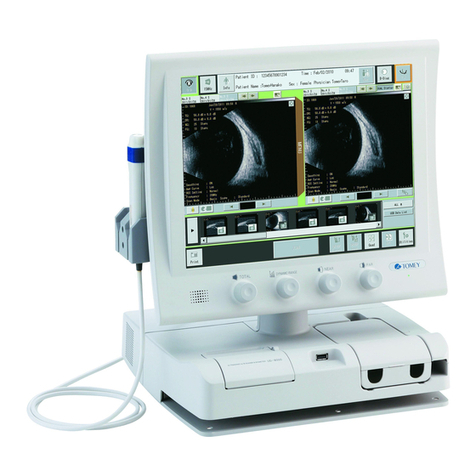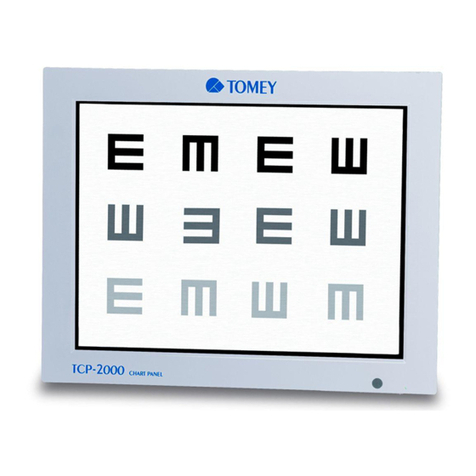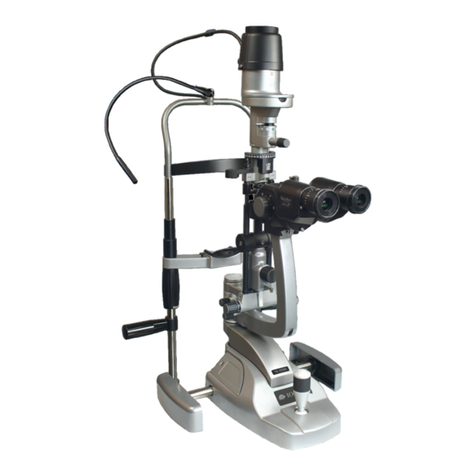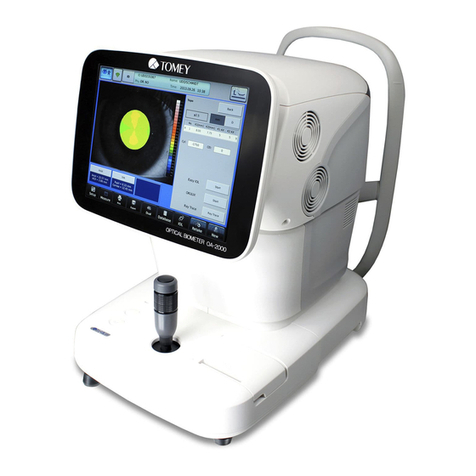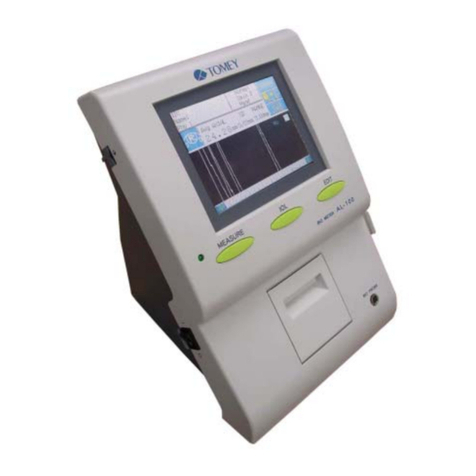Tomey TL-100 User manual

OPERATOR MANUAL
AUTO LENSMETER
TL-100
HOLD
• Read this Operator Manual carefully before using this instru ent in order to operate it
properly and safely.
• Do not use procedures other than those specified in this anual.
• Keep this Operator Manual handy when operating this instru ent.
• For any questions about this instru ent or about this anual, contact your local TOMEY
representative.

SYMBOLS USED IN THIS MANUAL
The symbols used in this manual represent the following messages:
• This is a precaution that, if unheeded, will result in a hazard-
ous situation where there is an imminent danger of serious
injury or death.
• This is precaution that, if unheeded, could result in a hazard-
ous situation where there is a possibility of serious injury or
death.
• This is a precaution that, if unheeded, may result in a situa-
tion where there is a possibility of minor or moderate injury or
damage to property.
• This is an additional instruction which may contain a special
precaution on company policy related, either directly or indi-
rectly, to the safety of personnel or to the protection of prop-
erty.
SYMBOLS USED IN THIS MANUAL
i

CONTENTS
1. PR OR TO USE ....................................................... 1-1
1.1 Cautionary notes ................................................................1-1
1.2 Unpa king ..........................................................................1-3
1.3 Explanation of terms...........................................................1-4
1.4 Outline of operation ............................................................1-5
2. COMPONENT L ST AND FUNCT ONS .................. 2-1
2.1 Front ...................................................................................2-1
2.2 Ba k ...................................................................................2-2
2.3 S reen layout .....................................................................2-3
3. METHOD OF OPERAT ON ..................................... 3-1
3.1 Preparation for operating ....................................................3-1
3.2 Measuring methods ............................................................3-3
3.2.1 Measuring single vision lenses ........................................ 3-3
a) Automati hold mode ................................................... 3-3
b) Manual hold mode ....................................................... 3-5
3.2.2 Measuring multi-fo al lenses (PROG mode).................... 3-7
a) Measuring progressive addition lenses........................ 3-7
b) Measuring bifo al lenses ........................................... 3-12
3.2.3 Measuring prism............................................................. 3-15
3.2.4 Measuring high index lenses (HI mode)......................... 3-16
3.2.5 Measuring onta t lenses (CL mode) ............................ 3-17
3.2.6 Re alling the readings (READING) ................................ 3-19
3.2.7 Dete ting progressive lenses ......................................... 3-20
3.3 Operating the lamp, marking devi e and lens table .......3-21
3.3.1 Clamp ............................................................................. 3-21
3.3.2 Marking devi e ............................................................... 3-22
3.3.3 Lens table....................................................................... 3-23
3.4 Setup ................................................................................3-24
3.5 LCD ontrast adjustment ..................................................3-28
3.6 Automati power saving fun tion (AUTO POWER OFF) 3-29
4. MA NTENANCE AND NSPECT ON ....................... 4-1
4.1 Warranty .............................................................................4-1
4.2 Routine maintenan e .........................................................4-2
4.2.1 Cleaning over glass ........................................................ 4-2
4.3 Repla ing spare parts ........................................................4-3
4.3.1 Fuse ................................................................................. 4-3
4.3.2 Ink artridge ..................................................................... 4-4
CONTENTS
ii

CONTENTS
iii
4.4 Storage............................................................................. 4-6
4.5 Pa king materials ............................................................. 4-6
5. TROUBLESHOOT NG ............................................. 5-1
5.1 Troubleshooting guide ........................................................5-1
5.1.1 General operation .............................................................. 5-1
5.1.2 Progressive addition lens measurement............................ 5-3
5.2 Error messages ..................................................................5-7
6. SPARE PARTS ........................................................ 6-1
7. SPEC F CAT ONS ................................................... 7-1
7.1 Measurement .....................................................................7-1
7.2 Data ontrol ........................................................................7-1
7.3 Physi al dimensions and ele tri al requirements...............7-1
7.4 Environmental onditions ...................................................7-2
7.5 Approved international standards.......................................7-2
8. NDEX ...................................................................... 8-1

iv
( This page is left intentionally blank )

1-1
1. PRIOR TO USE
• Read this Operator Manual carefully before using this
instrument in order to operate it properly and safely.
• Do not use procedures other than those specified in this
manual.
1.1 CAU IONARY NO ES
• Never install this instrument near locations where explosive
or flammable materials are used or stored. Such installation
may result in a fire or an explosion.
• Only well-trained personnel should operate this instrument.
• When installing this instrument, observe the following items.
- Do not install this instrument in a location where it might be
exposed to water or chemicals.
- Do not install this instrument in a location where it might be subject
to adverse influences, such as excessive atmospheric pressure,
high temperature, excessive humidity, poor ventilation, direct
sunlight, dust, salt or sulfur in the air.
- Ascertain that factors such as excessive slope, vibration and
impact will not endanger the instrument (including during
transportation).
- Do not install this instrument near the storage of chemical
substances or in a location where gas may be generated.
- Adhere to the specified mains fre uency, voltage and allowable
current (or allowable power consumption).
• During use of this instrument, observe the following:
- Do not move a coated lens when it is held with the clamp. This
may result in damage to the coating. The clamp should be used
only for marking.
- Clean the cover glass under the nose piece often with a soft cloth.
- Always keep the tip of the nose piece clean. Dust on it may result
in scratches on a lens.
1.1 CAUTIONARY NOTES

1-2
• When this instrument is not in use, keep the dust cover over
it.
• When the instrument is not used for an extended period of
time, unplug the power cord.
• After using this instrument, observe the following:
- Do not apply excessive force when unplugging the cords.
- Refer to the Section 4.4 Storage for storage instructions.
• If you suspect that this instrument is not functioning properly,
do not attempt to repair it. Contact your omey
representative or local distributor.
• Do not modify this instrument.
• Maintenance:
- Inspect this instrument and its accessories periodically.
- If this instrument has been idle for a long period of time, confirm
that it is functioning properly and safely before using it again. For
this, TOMEY recommends using a trial lens set for checking
accuracy.
• Due to vibration during transport and/or environmental
changes of storage, the ink may leak out of the marking
device cartridge. If you find an ink stain and/or leakage of ink
at the tip of the marking device, wipe it off and make sure it is
functioning properly.
1.1 CAUTIONARY NOTES

1-3
1.2 UNPACKING
Upon unpacking, inspect that all the components are present and that there is no
visible damage to any of them.
If there are any missing or damaged items, immediately contact your Tomey
representative or local distributor.
• Be sure to retain all shipping and packing materials for reuse
if the instrument will be transported or shipped.
1.2 UNPACKING
• Main unit of the AUTO ENSMETER T -100 ........ 1
• Power Cord ................................................................. 1
• Contact ens Nose Piece ............................................ 1
• Spare Fuse (250V, 2.0A) ............................................ 1
• Dust Cover .................................................................. 1
• Operator Manual (this book) ...................................... 1
HOLD
COMPONEN

1-4
1.3 EXPLANATION OF TERMS
1.3 EXPLANA ION OF ERMS
• D............................................ Diopter (a unit of measurement referring to the refractive power
of a lens; reciprocal of the focal length of the lens in meters)
•∆............................................ Prism diopter (a unit of the measurement of angular deviation
of light produced by a lens)
• SPH (S) ................................. Spherical refractive power (unit: D, diopter)
• CY (C) ................................ Cylindrical refractive power (unit: D, diopter)
• AXIS (A)............................... The position of minimum or maximum power in a lens that has
cylinder power. Axis is measured in degrees and is used to
specify the orientation of a lens to correct astigmatism. (unit:
degree)
• ADD ...................................... Additional power of a multi-focal lens (including a progressive
addition lens).
• C ......................................... Contact lens
• HI mode ................................ Measurement mode for high index lens
• Abbe number......................... Number indicating the dispersive power of a lens. The Abbe
number of normal lenses is about 60 and that of high index
lenses ranges from approximately 30 to 45.
• PSM ...................................... Prism

1-5
1.4 OUTLINE OF OPERATION
1.4 OU LINE OF OPERA ION
The AUTO ENSMETER T -100 is an instrument for the
automatic measurement of refractive and prism power of
spectacles and contact lenses.
The T -100 is composed of a built-in optical system, an
electronic processing system, and a mechanical system.
Placing spectacles or contact lenses on the nose piece initiates
automatic measurement. The results are displayed on the CD.

1-6
( This page is left intentionally blank )

2-1
2.1 FRONT
2. COMPONENT LIST AND FUNCTIONS
2.1 FRONT
Clamp
Stabilizes the lens when marking it.
Contrast adjuster
Adjusts the contrast of the LCD.
READ NG button
Displays the stored data.
LCD
Liquid Crystal display displays information
such as centering of lens, measurement condi-
tions and results.
HOLD
Marking device
Marks the center and axis orientation of the
lens.
Nose piece
Lens is placed on the nose piece.
Lens table
Used to standardize the orientation of spec-
tacles for accurate cylinder axis measurement
and vertical prism measurement.
HOLD button
Used for holding and storing the data.
MODE button
Selects single vision lens mode, multi-focal
lens mode or contact lens mode.

2-2
AUTO LENSMETER TL-100
S/N
MANUFACTURER
100-240V~ 50/60Hz 35VA
T2A 250V
ON OFF
NAME: TOMEY CORPORATION
ADDRESS: 2-11-33 Noritakeshinmachi,
Nishi-ku, Nagoya 451-0051 Japan
2.2 BACK
2.2 BACK
Name plate
Shows the serial number.
AC power terminal
The accompanying power cord is connected to this
terminal.
Power switch
Turns the power on or off.
Fuse holder
The fuse is mounted in this holder.

2-3
Alignment screen
Used for centering the lens
2.3 SCREEN LAYOUT
2.3 SCREEN LAYOUT
AUTO
HOLD
HI
ERROR
L R
MODE
CYL
STEP
PRISM PRISM AXIS
BO
BI
BU
BD
SPH CYL AXIS ADD
Data area
The reading is displayed.
Holding data
[HOLD]: ndicates the data are
being held.
ndication of the automatic
measurement mode
[AUTO]: Automatic measure-
ment mode
The lens to be measured
R: Right lens
L: Left lens
ndication of an ERROR
Lens modes
Single vision lens mode:
Multi-focal lens mode:
Contact lens mode:
High index lens mode
Measuremet Condition

2-4
( This page is left intentionally lank )

3-1
3. METHOD OF OPERATION
3.1 Preparation for operating
• Before turning on the power, check the following items:
- Make sure that the cover glass under the nose piece is clean.
- Make sure that the nose piece seated properly.
- Make sure a lens is not on the nose piece.
1) Connect the female end of the power cord into the power terminal on
the back of the TL-100 and the male end into a 3-prong power
outlet.
2) Turn the power switch ON.
3) The initial screen will appear for approximately five seconds.
Nose piece Cover glass
3.1 PREPARATIO FOR OPERATI G
HOLD

3-2
4) The measurement screen will appear.
AUTO MODE
CYL
STEP
R
SPH CYL AXIS ADD
• Do not place a lens onto the nose piece until after the
measurement screen appears.
• Turning the instrument on with the lens alrea y on the
nose piece initiates a beep an in icates "INITIAL ERROR"
on the LCD. Remove the lens from the nose piece, then
press any button to procee .
ERROR
3.1 PREPARATIO FOR OPERATI G

3-3
3.2 MEASURI G METHODS
3.2 MEASURING METHODS
3.2.1 MEASURING SINGLE VISION LENSES
If the instrument is not in Single Vision mode ( ), change to
Single Vision mode by pressing the MODE button. Single Vision
mode ( ), Multi focal mode ( ) and Contact Lens mode ( )
are set consecutively each time the MODE button is pressed.
a) Automatic Hold Mode
In the automatic hold mode, readings are automatically held when
the lens is properly aligned.
• Thrusting a lens onto the nose piece or moving a lens
quickly may result in amage to the lens.
1) If the instrument is in manual hold mode and you wish to use
automatic (AUTO) hold mode, press the HOLD button for
approximately 1 second until "AUTO" appears at the upper left of
the screen.
2) Place the right lens on the nose piece with the bottom of the frame
away from you and the temple downward (as shown below).
H
OLD
AUTO
HOLD MODE
CYL
STEP
R
SPH CYL AXIS ADD

3-4
• T e rig t lens must be measured first and t en t e left lens.
3) Move the lens gently right and left, back and forth to center the
cursor (+) on the crosshair. The reading will be displayed in real
time.
4) When alignment is achieved, a beep will sound and the reading will
be automatically held.
MODE
CYL
STEP
SPH CYL AXIS ADD
R
HOLD
AUTO
5) When the right lens is removed from the nose piece, the instrument
is ready to measure the left lens.
6) Place the left lens on the nose piece as described in step 2 and
follow steps 3 4.
• When the left lens is place on the nose piece, "HOLD" will
isappear from the screen. However, the right lens ata will
be retaine , an if the Output button is presse after
measuring the left lens, ata for both lenses will be
isplaye .
3.2 MEASURI G METHODS

3-5
b) Manual Hold Mode
• Thrusting the lens onto the nose piece or moving the lens
quickly may result in amage to the lens.
1) If the instrument is in automatic (AUTO) hold mode and you wish
to change to manual hold mode, press the HOLD button (located
below the nose piece) for approximately 1 second, until "AUTO"
disappears from the display.
2) Place the right lens on the nose piece with the bottom of the frame
away from you and the temples downward (as shown on page 3 3).
• The right lens must be measure first an then the left
lens.
MODE
CYL
STEP
SPH CYL AXIS ADD
R
3) Move the lens gently right and left, back and forth to center the
cursor (+) on the crosshair. The reading will be displayed in the
data area in real time.
3.2 MEASURI G METHODS
Table of contents
Other Tomey Medical Equipment manuals
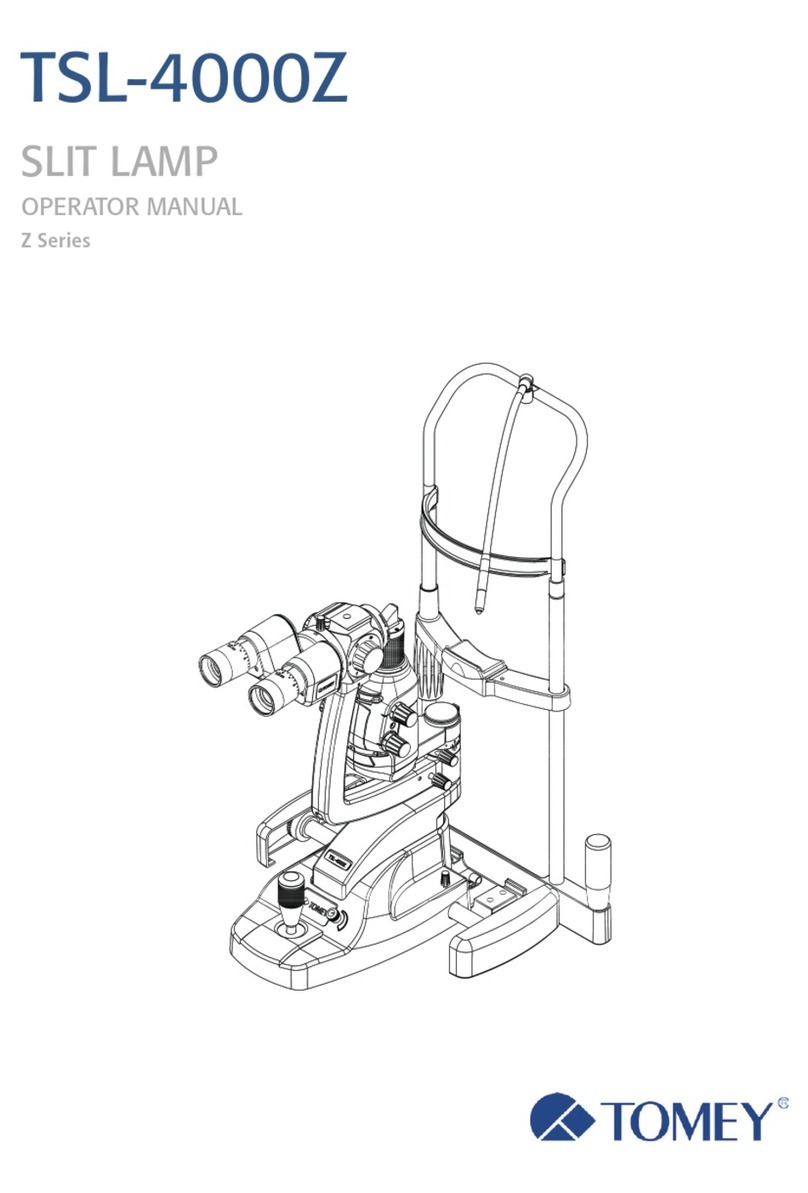
Tomey
Tomey TSL-4000Z User manual
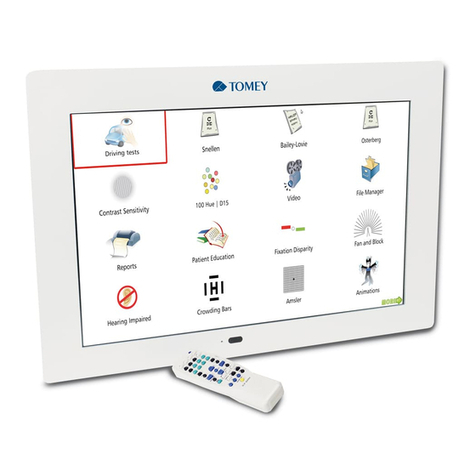
Tomey
Tomey TCP-2000P User manual
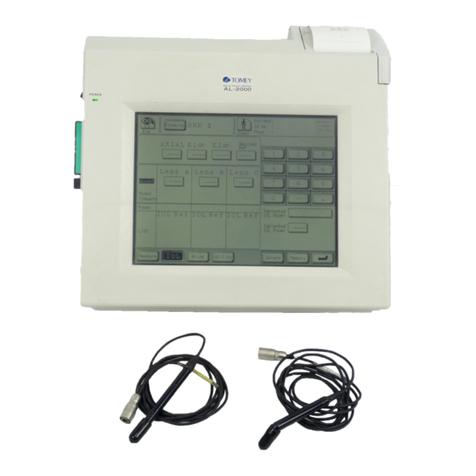
Tomey
Tomey AL-2000 User manual
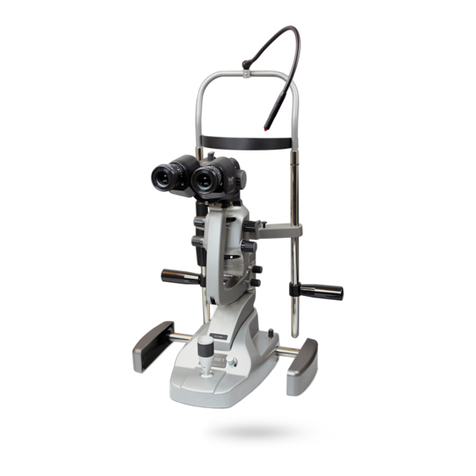
Tomey
Tomey Z Series User manual
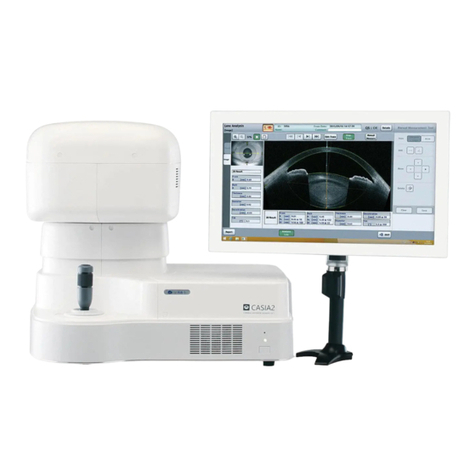
Tomey
Tomey CASIA2 User manual
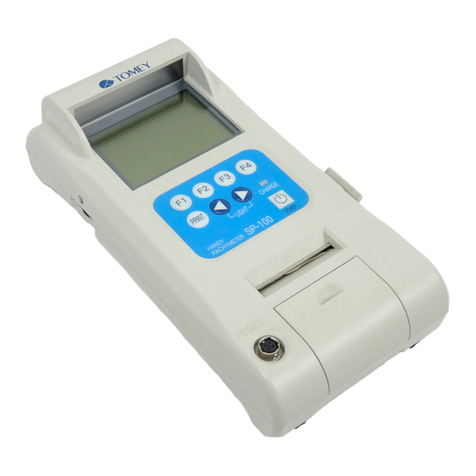
Tomey
Tomey SP-100 User manual
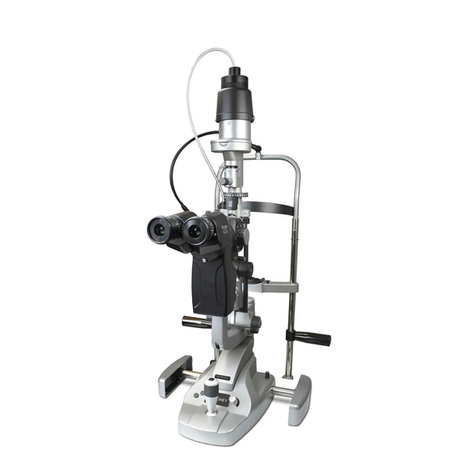
Tomey
Tomey TSL-7000Hdigital User manual
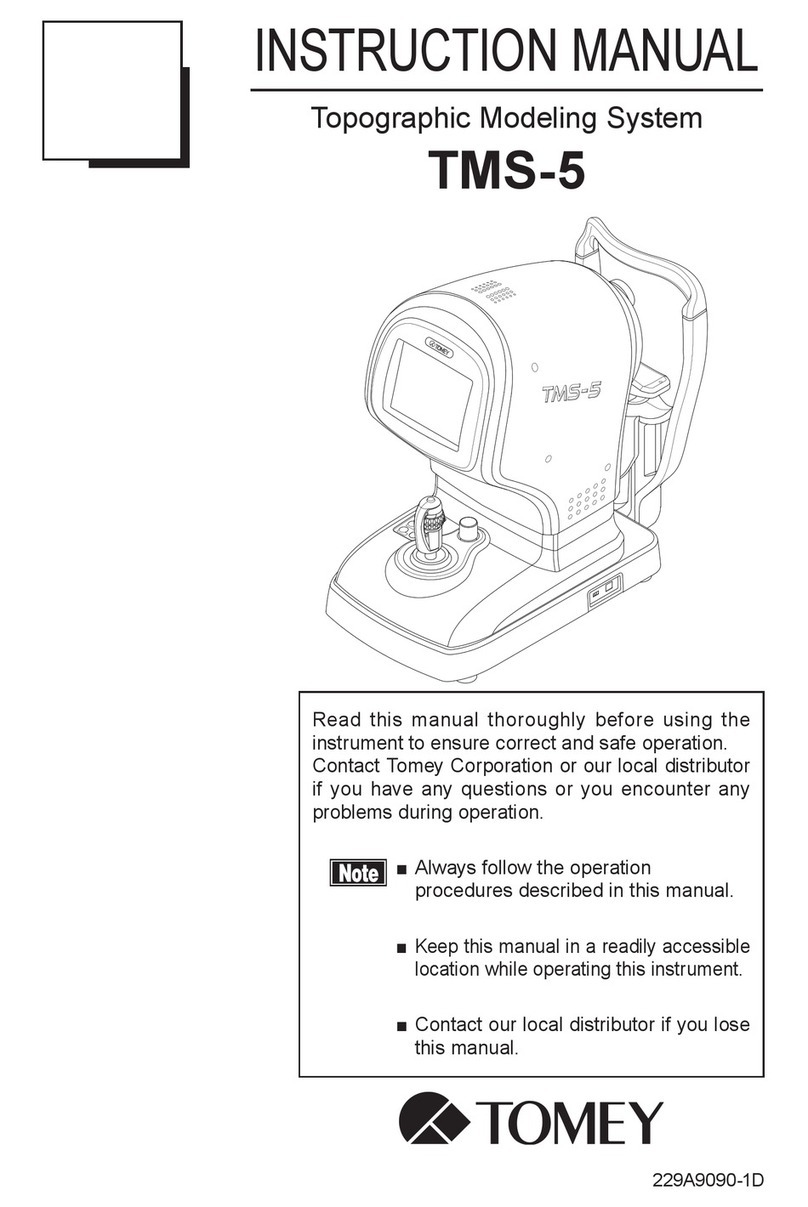
Tomey
Tomey TMS-5 User manual
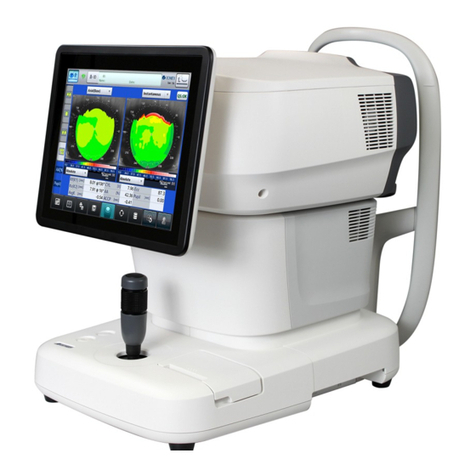
Tomey
Tomey MR-6000 User manual

Tomey
Tomey SP-100 User manual
Popular Medical Equipment manuals by other brands

Getinge
Getinge Arjohuntleigh Nimbus 3 Professional Instructions for use

Mettler Electronics
Mettler Electronics Sonicator 730 Maintenance manual

Pressalit Care
Pressalit Care R1100 Mounting instruction

Denas MS
Denas MS DENAS-T operating manual

bort medical
bort medical ActiveColor quick guide

AccuVein
AccuVein AV400 user manual
